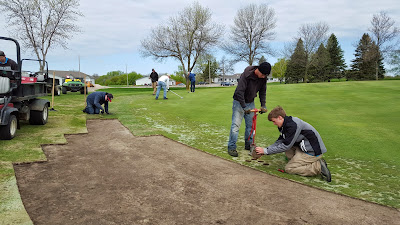This situation presents a bit of a double-edged sword for us. The greens are in much less than desirable condition right now with the voids from all the dead Poa leaving the putting surfaces about as smooth as a gravel parking lot. Conversely, if the Poa decides it doesn't want to come back, great. We are doing all that we can so far this spring to push the bentgrass into filling in the voids where the Poa died. The more bentgrass is in our greens and collars, the less we will have to deal with scenarios like this in the future.
So far this spring we have been doing all that we can to keep the bentgrass spreading out into the dead voids. A little bit of extra topdressing sand has helped level out the depressions making the greens putt a little smoother, and giving the bentgrass something to spread into. Furthermore we have been filling some of the larger voids with bentgrass plugs from our practice green, utilizing smooth rollers on our cutting units, doing a bit of spot seeding here and there, and regularly rolling. Combined with a little bit of extra fertilizer and the areas are slowly starting to fill in. However, it is a long road back back in some areas still.
 |
| Lots of plugs in the front of 11 green |
 |
| Getting started cutting plugs out of the practice hole green. We will likely take another 1,000 more before its all said and done. |
Lastly, 16 green is showing some serious recovery after having been seeded and covered for the last few weeks. All of our bentgrass seed germinated (although amazingly, almost no Poa seeds did.) We will likely open hole 16 back up in the next few days as the new bentgrass seedlings start to mature and take hold. It will likely putt a bit slower than the rest of the greens for a few weeks as we continue to go easy on it to allow for complete recovery.
 |
| Lots of bentgrass seedlings are filling in the bare areas in 16 green. It should make an almost complete recovery here in the next few weeks. |













